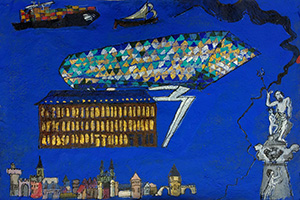 Antwerp is a river port, just like Hamburg, and is the second largest port in Europe, after Rotterdam. The city is located on the Scheldt, just a hundred kilometers from the North Sea. The Scheldt is a river as beautiful as it is conflictual: it has been fought over for centuries because of its strategic location and the trading cities on its banks. But the river itself was also problematic: the North Sea constantly brought in silt, currents and sandbanks were and are erratic, storm surges ravaged the area. Because ships became larger and deeper, they could sometimes only reach Antwerp with great difficulty, or even got stuck in the river.
Antwerp is a river port, just like Hamburg, and is the second largest port in Europe, after Rotterdam. The city is located on the Scheldt, just a hundred kilometers from the North Sea. The Scheldt is a river as beautiful as it is conflictual: it has been fought over for centuries because of its strategic location and the trading cities on its banks. But the river itself was also problematic: the North Sea constantly brought in silt, currents and sandbanks were and are erratic, storm surges ravaged the area. Because ships became larger and deeper, they could sometimes only reach Antwerp with great difficulty, or even got stuck in the river.
A few times in its history, Antwerp was a world port, only to become a modest regional port, before returning to the world stage.
Around 1500 Antwerp took over the role of Bruges as the leading port. Bruges was connected to the North Sea by the river Zwin, but the Zwin silted up and merchants and skippers chose Antwerp. The city became a hub of trade between England, Germany, the Hanseatic cities, Italy and Portugal. English cloth, German metal, spices that Portuguese ships had brought from Asia and sugar from the Portuguese islands changed hands here.
But not only merchants, but also writers and famous painters such as Jan and Pieter Breughel, Anthony van Dyck and Peter Paul Rubens lived in the city. And printers of books and nautical charts, such as the mapmaker Christoffel Plantin, lived in Antwerp. Due to the increasing international shipping, there was a great need for nautical charts and other nautical knowledge.
After the Eighty Years’ War (1568-1648), in which Antwerp was besieged by the Spaniards and captured, the flexible commercial spirit and cosmopolitan atmosphere in Antwerp were over. Half the population fled; many merchants, with their Mediterranean experience and trade contacts, settled in Amsterdam, which subsequently became an important world port. Antwerp sank. The diamond industry, which had mainly settled in the city by the Portuguese, remained.
At the end of the nineteenth century, Belgium took possession of Congo, an area that was enormously rich in raw materials and that was eighty times the size of Belgium, so products and raw materials flowed into Antwerp: ivory, rubber, diamonds, copper, tin and so on. Antwerp became a rich city again. The Belgian administration of Congo was accompanied by extreme violence and cruelty. Congo became independent in 1960.
After World War II, the port received a lot of American support, in the form of American arms transports and Marshall Aid. Numerous petrochemical companies settled there; Antwerp became the second largest chemical cluster in the world. All kinds of villages and lands had to give way.
The port of Antwerp is responsible for 16 percent of Belgium’s total CO2 emissions. She sees greening of the port as one of her priorities and wants to become a hub for green energy. The port has ambitious climate plans and aims to be climate neutral by 2050. In 2021, the port of Antwerp has merged with the port of Zeebrugge. The old competitors Bruges and Antwerp are now allies.




